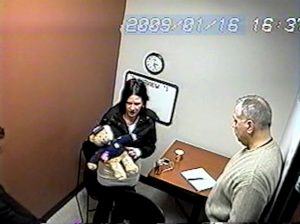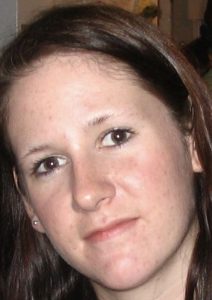Defense demands new look at Calusinski case
By Gregory Harutunian for Chronicle Media — January 30, 2025
Melissa Calusinski holds a teddy bear to depict her actions, as former Lake County Major Crimes Task Force Chief George Filenko looks on, during a nearly 10-hour interrogation. Court experts have pointed to red flags indicating coerced interactions. (File photo)
The clemency petition for Melissa Calusinski is now in the hands of Gov. J.B. Pritzker, for a determination, with no timeline regarding its disposition.
The Illinois Prisoner Review Board forwarded its recommendation this month, and exceeded the 60-day period to do so, claiming a backlog of cases.
Calusinski, 38, was convicted in the 2009 death of 16-month-old Benjamin Kingan, at a Lincolnshire daycare facility. She is currently serving a 31-year sentence for first-degree murder and the aggravated battery of a child.
Questions of a wrongful conviction have always been attached to the case. They result from an apparently coerced confession over a 9½-hour period, problematic testimony, evidence that may have been altered or withheld to the defense team, histology slides showing a chronic injury, and an aggressive prosecution.
The most troubling aspect revolves around evidence that may have been altered or tampered with, specifically X-rays of the child’s head. The fact was highlighted at the July 9 prisoner review board hearing in Springfield that the original images in the state’s possession, prior to the trial, were manipulated.
Orlando, Florida-based Garrett Discoveries appeared at the hearing, confirming that the images had been darkened and reduced in clarity making them virtually unreadable. These altered images were passed to the defense, and had been composed while in the state’s possession on the county coroner’s own equipment.

Melissa Calusinski has been serving a 31-year sentence for a controversial apparent wrongful conviction. (File photo)
“The theory of the state was that the child was thrown down with such force, as to cause a skull fracture,” said Paul DeLuca, the original defense attorney. “There was a dispute at trial, as to whether this was a fracture or a normal appearance of growth plates on the skull. The state argued more than 30 times that it was a fracture.
“This is damaging testimony for a jury to hear,” DeLuca said. “I did not receive any X-ray evidence until about three weeks, prior to trial … they were very dark and showed nothing. Despite testimony by the county coroner physicians, if we had readable X-rays showing no fracture, we would have hired an expert to review them and refute it.”
The information was also presented during a Jan. 18 episode of CBS “48 Hours,” “Unraveling The Case Against Melissa Calusinski:” (https://www.cbs.com/shows/video/Rx4AFWbG7Ii_BqxNhyC6ELe73N9RvxR1/)
Representatives of Garrett Discoveries and DeLuca both reiterated their findings during the program.
“The main reason we pursued this was after the county state’s attorney (Eric Rinehart) suggested a company to get to the bottom of why the defense got no clear X-rays,” said Erin Moriarty, the “48 Hours” reporter-correspondent. When they (Garrett) reported the X-rays had been manipulated on the coroner’s computer … that was the reason.
“None of the experts at trial testified that they saw clear X-rays,” she said. “That was a really important fact to raise, which is that all of the available evidence was not shown at trial. Also, not only is Melissa’s future at stake … but a 16-month-old baby died, and we should know why.”
Then-Lake County Coroner Dr. Thomas Rudd had long championed histology slides showing an existing chronic bleeding injury on the back of the child’s head, a subdural hematoma, when blood collects outside the brain. Rudd changed the manner of death, from homicide to undetermined. He also explained how the readable images came to light.
“Early in 2015, an anonymous source contacted Melissa’s father, and stated readable images were at the coroner’s office and at the hospital where the child was pronounced deceased,” said Rudd. “An employee was called in, who pulled up the readable images. They were then given to the current defense attorney, Kathleen Zellner.”
An evidentiary hearing, presided over by Lake County Circuit Court Judge Daniel Shanes, determined the images were not new evidence warranting a new trial. Zellner filed an appeal with the State of Illinois Second District Appellate Court in Elgin, which also eventually denied a hearing.
Although DeLuca says he and Zellner met with Rinehart in July and December 2022, there has been no movement on legal proceedings.
Zellner filed a Writ of Haebeus Corpus for Melissa’s release in Federal Court, where it languished for five years. The motion was dropped in favor of a direct appeal to the Illinois Prisoner Review Board for clemency.
Rinehart did tender a letter to the board, stating, “Regarding Melissa Calusinski, no such new evidence has been presented to our conviction integrity unit, or in this clemency process.”
Zellner did not respond to a request for comment. Rinehart’s office replied via email, “We cannot comment on this case, at the moment.”
Moriarty said, “While an evidentiary hearing in 2015 deemed the readable images as not new evidence, at the very least, it demands a new look.”






